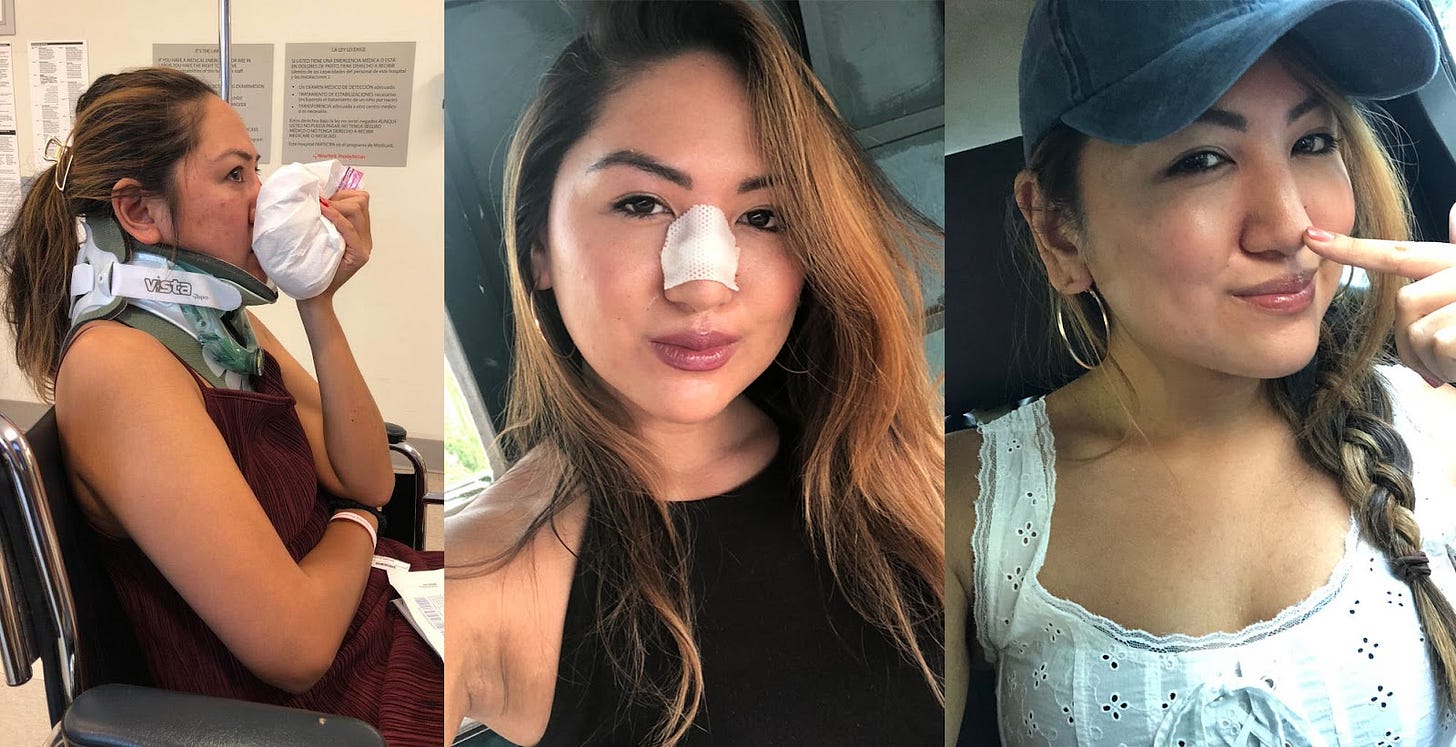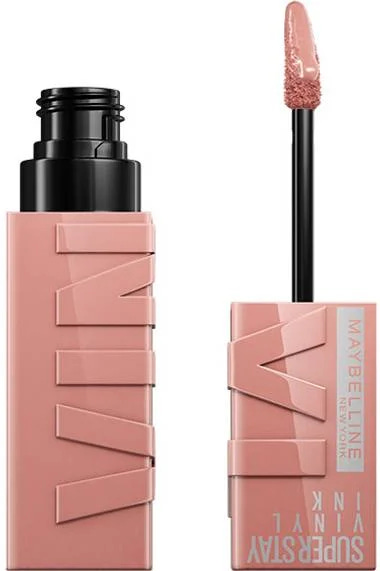Learning to Love My Filipino Nose
A deep dive into Filipinos' obsession with having a "tall" nose – and how to finally free yourself of an impossible beauty standard.
Welcome to Pearl, a bi-weekly newsletter dedicated to Filipinas and their beauty journeys. Read more about its mission here.

“How much would a full rhinoplasty be?”
I asked this while seated in a plastic surgeon’s office, ready to pay for what was supposed to be a medical procedure. Back in 2018, while carrying laundry down the stairs, I missed a step and fell down a full flight, landing on my face. I rushed to the ER, where a surgeon confirmed my nose was broken and that I needed surgery, stat. The plan was to “reset” my nose to put the bone back in place, which wouldn’t change its original shape. But, as many Filipinas may relate, my nose was my biggest insecurity. It’s wide, with a rounded tip that slopes downward – features widely seen as undesirable in a culture still strongly influenced by white-centric beauty ideals. Maybe you’ve heard the term pango, or a flat nose. It’s a dreaded descriptor. I thought surgery could be a chance to evade it, once and for all.
When the office told me a full rhinoplasty would be $18,000(!), I threw all fantasies of a new nose out the window. Then, the guilt settled in. Shouldn’t I be proud of my features? Shouldn’t I embrace my Filipino nose? How could I be so ready to change it? If you identify with these feelings, it’s not your fault.
Instilling the desire for a “tall” nose starts young. While scrolling through TikTok, I recently found a comment on a video of a Filipino baby: “Very cute baby. Plz put clip on her nose it is too big.” The audacity! Unfortunately, using laundry clothespins to pinch a baby’s nose so it will be slimmer is incredibly common in Filipino households. The belief is that you can reshape a child’s nose while they’re young and their features haven’t “settled” yet. This, of course, is total B.S (not to mention painful for a child). Your nose is entirely up to genetics, no matter how many contraptions like the Magic Nose reshaper (one I saw recommended on a Filipino forum) keep selling.
Recently, I came upon a whole children’s book titled Why Do Filipinos Have Flat Nose? by Ofelia Concepcion. I don’t know how legitimate this book is considering the grammar in the title, but a Philippines-based blogger detailed all the pages explaining how one day, a goddess of beauty made it rain noses and Filipinos got the last pick of the lot. “They were dismayed in getting only the flat noses that were deformed with the struggle,” the book reads. Stories like this seem harmless, but they reinforce ideas of self-loathing to the most impressionable minds. Here, it’s telling a reader that a flat nose is undesirable. A flat nose symbolizes being in “last place.” The leftovers. How is that supposed to make a child with a Filipino nose feel?

It’s not just kids made to feel insecure, it’s adults too. I came across plastic surgery forums asking “What can be done for my Filipino nose?” and countless YouTube videos and tutorials like this instructing Filipinos how to contour their noses. While there’s nothing inherently wrong with the makeup technique (I contour too) – it’s the context. “As Pinays, we tend to be sensitive to having a pango (flat, broad) nose. That’s why contouring the nose is so appealing to us!,” one writer shared on a blog, “I perceive my nose as the round type, so this technique is what I usually follow, especially since I have nose envy for the slim tips I see on Kate Beckinsale and Sarah Michelle Gellar!” Notice how they’re two white women. No shade to this writer, but it breaks my heart that so many Filipinas aspire to look like white women, striving for an ideal that is physically impossible for us.
The wild thing is that in pre-colonial Philippines (particularly in the Visayas), skull molding and face binding were a regular practice because flat foreheads and flat noses were considered desirable! Imagine that.
So, where do we go from here?
As someone who works in the beauty industry, I feel like everyday is a battle of trying to let self-love win over external forces telling me I am not enough. Accepting yourself – physical features, and all – is a daily practice. I learned this from Alyssa Lia Mancao, LCSW, a Filipina therapist I once interviewed for an article on social media’s impact on self-esteem. When we spoke, she shared actions you can try the next time you feel yourself getting caught in an insecurity spiral because of your facial features (or otherwise!).
“I recommend that people do exercises where they look at themselves in the mirror and just describe their appearance without using any subjective language,” she told me. “Instead of saying ‘my cheeks are chubby,’ be able to say ‘I have two cheeks.’ Give appreciation to your body for what it has and not how it looks like,” she advised. Instead of thinking: Ugh, my nose is flat/round/ugly, draw your attention to its function and what you appreciate about it: My nose allows me to smell and taste my parents’ cooking, it allows me appreciate my favorite flowers/perfume, it connects me to my memories.
Alyssa, who specializes with inner child healing, also suggests looking back at a photo of your younger self. “Imagine that version of you. Imagine that little child is saying ‘I hate my body,’ or ‘I hate my face.’ What would you say to that younger version of you?” she said, “I don’t think you would say to them, ‘You’re right.’ You would probably say, ‘You’re beautiful, how could you ever think that?’ We need to reconnect with that part of us and give ourselves that love and compassion.”

I know this is easier said than done. In practice, it may even feel awkward and uncomfortable. But, the first step of unlearning oppressive beauty standards is to raise awareness of our inner thoughts and the outside forces that influence the way we feel about ourselves. I’m not here to shame anyone who has had surgery or other work done. I’m just here to say: Your nose is the least interesting thing about you. Your looks are the least interesting thing about you. However tall, flat, round, sharp, skinny, or wide this lump of cartilage and bone in the middle of your face appears has nothing to do with your beauty–or your worth.
Product Spotlight: Maybelline SuperStay Vinyl Ink Liquid Lip Color
I am always on the hunt for a no-budge lipstick. I’ve been a longtime fan of the Rouge Dior Forever Liquid Lipstick, but I think this drugstore alternative has even better staying power! And it’s under $12. I swatched all the shades on my hand, washed them vigorously with soap and water, and they would not come off. I ate with it, drank with it, and even made my fiancé kiss-test it to see just how long-wear it is. ZERO transfer. I was so impressed it miiiight just be my wedding day lipstick.
Links I’m loving:
Transform any outfit of yours into a modern Filipinana with these add-on butterfly sleeves! I met the designer Nikki at a recent Filipina on the Rise event and immediately fell in love with her “Niana” sleeves, a creative take on the terno. They come in multiple colors and tie in the back for a cute detail. Orders haven’t opened yet, but these are going to blow up, I just know it!
Were you guys aware of these ready-made sauces of Filipino dishes like kare-kare, adobo, and kaldereta? They’re available at Whole Foods. I had no idea and as someone who is, um, *challenged* in the culinary department and always in a time crunch, these could be a game-changer!
I love seeing H.E.R. talk about how growing up in the Bay Area and around so many Filipinos influenced her career. It’s refreshing when high-profile celebs talk proudly about their Filipino heritage instead of making it an afterthought! I can’t wait for her to play Belle in the concert of Beauty and the Beast: A 30th Celebration.
Can you imagine if Lea Salonga surprised you at your wedding with a medley like she did here? I would simply pass out!!!
The Sephora Holiday Savings event is happening and I’m getting some DMs from you guys asking for suggestions! I have a few in my IG Highlight here. I’ll keep sharing more over the next couple of days.
How can I support Pearl?
If anything you read resonated or you learned something new, please share this newsletter with a friend. Forward the subscribe page, post an excerpt on IG stories and tag me, and make sure you’re following me over on Instagram and TikTok.
With love,
Kristina








Just stumbled across your work and I'm so happy to find a filipino fashion/beauty/make-up account!! thank u for writing this <3
So sad to see so many Filipinos who still have the colonialist mindset. Thank you for sharing your insights and raising awareness on this!